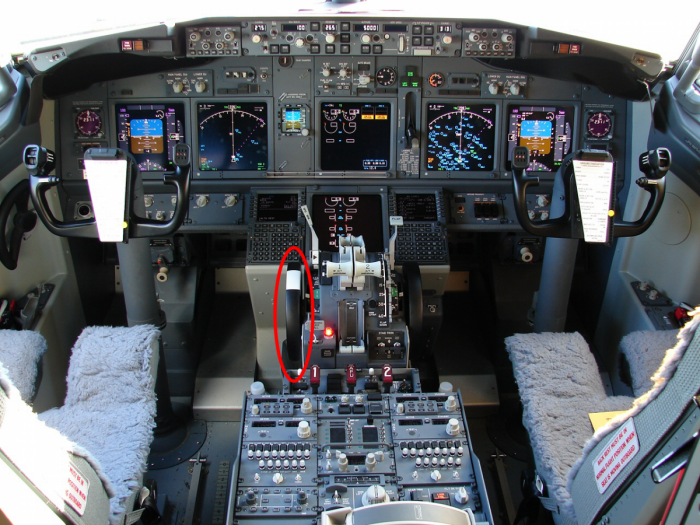Trim is the control that adjusts the trim tab. Effectively its a way to fine tune/change the control surface to elevate control forces. Since airplanes can be loaded differently and the Center Of Gravity moves as the aircraft burns fuel the control surfaces must be slightly adjusted for each flight/flight segment to achieve straight and level flight for a given configuration/load.
If the aircraft is trimmed, the flight controls are in a state where no force needs to be exerted in order to continue straight and level flight. Aerodynamic and gravitational moments about all three axes are nulled out.Changing the trim of the aircraft in pitch could happen in the following ways:a shift in centre of gravity, for instance by shifting fuel from centre tanks to tail tanks, or payload shifting position; a change in thrust of an engine that is located above or below the centre of gravity; a change in horizontal tail angle or trim tab; a deflection of the elevator.
If the aircraft was in straight and level flight and the trim changes because of a change in any of the above, it can be compensated for by the other factors. Elevator deflection is fastest but requires a pilot force which is uncomfortable for longer periods, that is why the forces can be trimmed out to make the new stick position the neutral force one.The most commonly used trim system is the trim tab which can be installed in both fixed or flight adjustable configurations. Adjustable springs, anti-servo tabs on a stabilator equipped aircraft and a trimmable horizontal stabiliser are other types of trim systems.
**Which situation?
The trim is generally adjusted any time the aircraft transitions flight phase (climb to cruise, cruise to decent etc) or when the power setting is changed or periodically in cruise if the CG is greatly effected. For example if you climb out at full power, reach your cruising altitude of 3000 ft. push the nose over and pull the power back to your cruise power setting you may find you are still applying forward control pressure to keep the airplane from climbing. In this case you would trim off the control pressure by rolling the wheel forward until you no longer needed to apply control pressure to keep the plane level. At this point you could fly "hands off".
*Static stability exists when an aircraft is trimmed for a condition and then moved will return as trimmed.
* A statically stable aircraft is easier to fly.
* A statically unstable aircraft is harder to fly.
* A statically stable aircraft exists when the CG is forward of the wing lift.
* The closer the centre of wing wing lift gets to the centre of gravity the more unstable the aircraft.
* FARs require aircraft to be statically stable with respect to speed changes.
* Lift is commonly close to 25% aft of wings chord from the leading edge.
* Trim is used to adjust the tail to counter wings lift forward of the centre of gravity by giving down-load.
* The forward C.G requires a tail download as any reduction in speed will lower the nose as a recovery.
* About one pound of pressure on the yoke is required for every six knots to prevent a change in airspeed.
* Friction of control and connections is a constant difference related to aircraft speed.
* You must overcome this designed-in friction before the controls move.
* FRSR is a term meaning free return speed range.
* The FRSR is the range of speeds that can be stabilized with a single trim setting.
* Aft CG conditions lower the FRSR speed ranges.
(Basic Explanation by Anas Maaz)
Trimming is cutting out the control forces to zero. It is used in take off, cruise and landing (yes, all the time). In General aviation aircraft, this is achieved by an elevator and a trim tab combination. When the pilot push the controls, the elevator moves down creating an up force through the hinge and creates elevator hinge moment.To keep this going with minimal or no inputs from the pilot, he adjusts the trim.
In this situation, nose down trim is applied. This moves the trim tab up generating a down force. This force also acts through the elevator hinge. Once the tab moment and elevator moment becomes equal the aircraft will be in trim. That is zero stick force will be required to maintain the flight in the regime.In Commercial airplanes things are a lot different. Because of their size a small trim tab is not going to be much of an use. But they also need a way to stay nicely trimmed. To achieve this, they have something called a Variable Incidence tailplane.
As the name suggests, the pilot can vary the incidence angle of tailplane here. Still, the pilot to control the pitch pulls the elevator up or push it down. Let's look at an example. If the pilot wants to move up, he would move the elevator up. To trim the airplane the pilot now will have to apply nose up trim. As he does this, the tailplane will decrease its incidence via a jack screw. This is continued until the elevator and the tailplane are inline. This balances load from both surfaces which makes the stick forces zero.
Some advantages of VI tailplane include a more powerful means of trim, can operate at higher ranges of CG and lower drag profile as less of the airplane is exposed to the air flow. One disadvantage is if the trim runs out of position, the airplane might go bonkers. As tailplane creates a much higher moment, there is no way the much smaller elevator can neutralise it. But there are mechanisms placed to avoid this.One final point. Fly by wire aircraft have auto trim. So, Airbus pilots don't have to trim the airplane. It is done automatically by the computer.













ليست هناك تعليقات:
إرسال تعليق